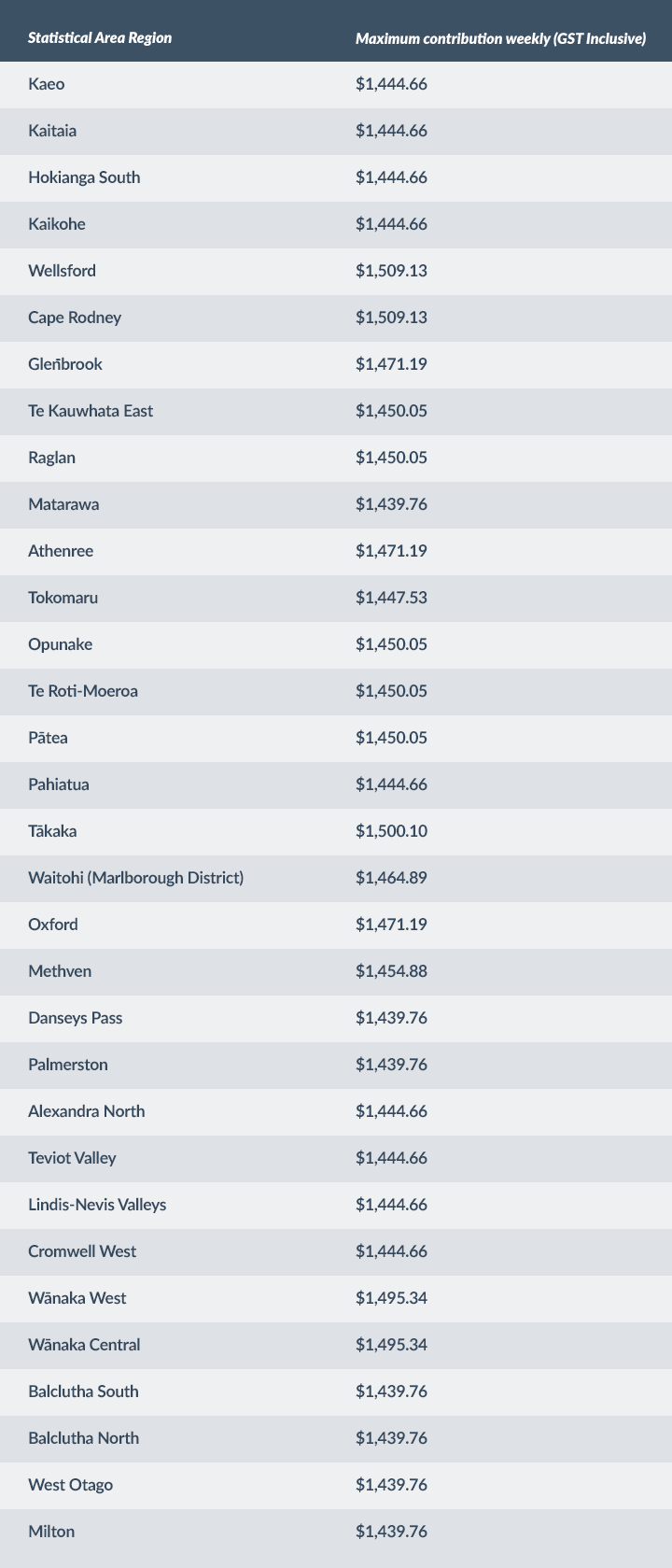
There is an upper limit to what a care home can charge for residential care – this is known as the ‘maximum contribution’. This article explains how the maximum contribution works.
What Does the Maximum Contribution Cover in Residential Care?
In New Zealand, the cost of residential care varies depending on several factors, including the level of care required, the care facility chosen, and the type of room occupied.
However, there is a limit to what care homes can charge for contracted care services, which is known as the 'maximum contribution.'
This article explains how the maximum contribution works and what it does and doesn’t cover.
What Is the Maximum Contribution?
The maximum contribution is the upper limit that care homes can charge for rest home level care services, as outlined in the Age-Related Residential Care (ARRC) Agreement. This amount is set annually and varies by location.
As of now, the maximum contribution ranges between $1,399.16 to $1,511.09 per week. Government subsidies are available to help cover the cost of care but are subject to financial means testing.
What about higher level care?
The maximum contribution covers contracted care services for residents receiving rest home level care. If a resident requires a higher level of care, such as hospital or dementia level care, the additional cost beyond the maximum contribution is covered by a 'top-up' subsidy. This subsidy is funded by the Ministry of Health and is available to all residents, regardless of whether they receive a government subsidy or are paying privately and is paid directly to the care provider.
A resident will need to complete a Needs Assessment to determine which level of care they require. A Needs Assessment may be completed more than once if there is a change in a resident’s circumstances.
Does the maximum contribution ever change?
The maximum contribution is adjusted annually on the 1st of July.
What Does the Maximum Contribution Cover?
The maximum contribution covers rest home-level care in a residential facility, including:
- Accommodation: This includes meals, cleaning, and laundry services.
- Nursing and other basic care: Regular care provided by the facility’s staff.
- Doctor or nurse practitioner visits: One visit upon admission, followed by monthly check-ups or every three months at the doctor's discretion.
- Medications: All prescribed Pharmac-approved medications
- Dressings and treatment supplies: Any necessary medical supplies used in treatment.
- Continence products: To meet the resident’s assessed needs.
- Communal equipment and mobility aids: These are shared among all residents.
- Regular activity programmes: Activities that are part of the care home’s routine schedule.
- Physiotherapy, dietician advice, speech therapy, and podiatry: When prescribed by a doctor or nurse practitioner.
- Temporary absences: The subsidy covers up to 14 days of absence at a time (maximum 28 days a year) or up to 21 days if admitted to a public hospital, with the potential for extension based on needs assessment.
- Transport for health reasons: e.g. transport to and from local public hospitals.
- Accompaniment to health appointments: If family or friends are unavailable, someone will be provided to accompany the resident.
What Does the Maximum Contribution Not Cover?
While the maximum contribution covers essential care services, there are some costs that residents continue to pay for personally. These include:
- Premium rooms: e.g., larger rooms or those with ensuites.
- Personal services: Such as hairdressing.
- Private medical services: Dentists, opticians, audiologists, and any private specialists or X-rays not arranged by the care home.
- Personal items: Including hairbrushes, razors, TV, radio, cigarettes, and batteries.
- Basic toiletries: Soap, shampoo, toothpaste, toothbrushes, and other personal care items.
- Personal clothing and dry-cleaning.
- Wheelchairs for exclusive use.
- Insurance of personal belongings.
- Private telephone, toll calls, internet, or Sky TV.
- Entrance fees to events: Such as shows or concerts.
Maximum contributions around New Zealand
The following tables outline the maximum contribution rates for residential care across New Zealand, with rates varying based on the location of the care facility.
In most cases, the rate is determined by the boundaries of each Territorial Local Authority (TLA). However, for certain smaller subregions, known as Statistical Areas (the second table), a higher rate may apply—particularly in rural areas where costs are typically greater.
For more information on the boundaries of these TLAs and Statistical Areas, Statistics New Zealand offers a geographic boundary viewer that maps out these regions across New Zealand.

